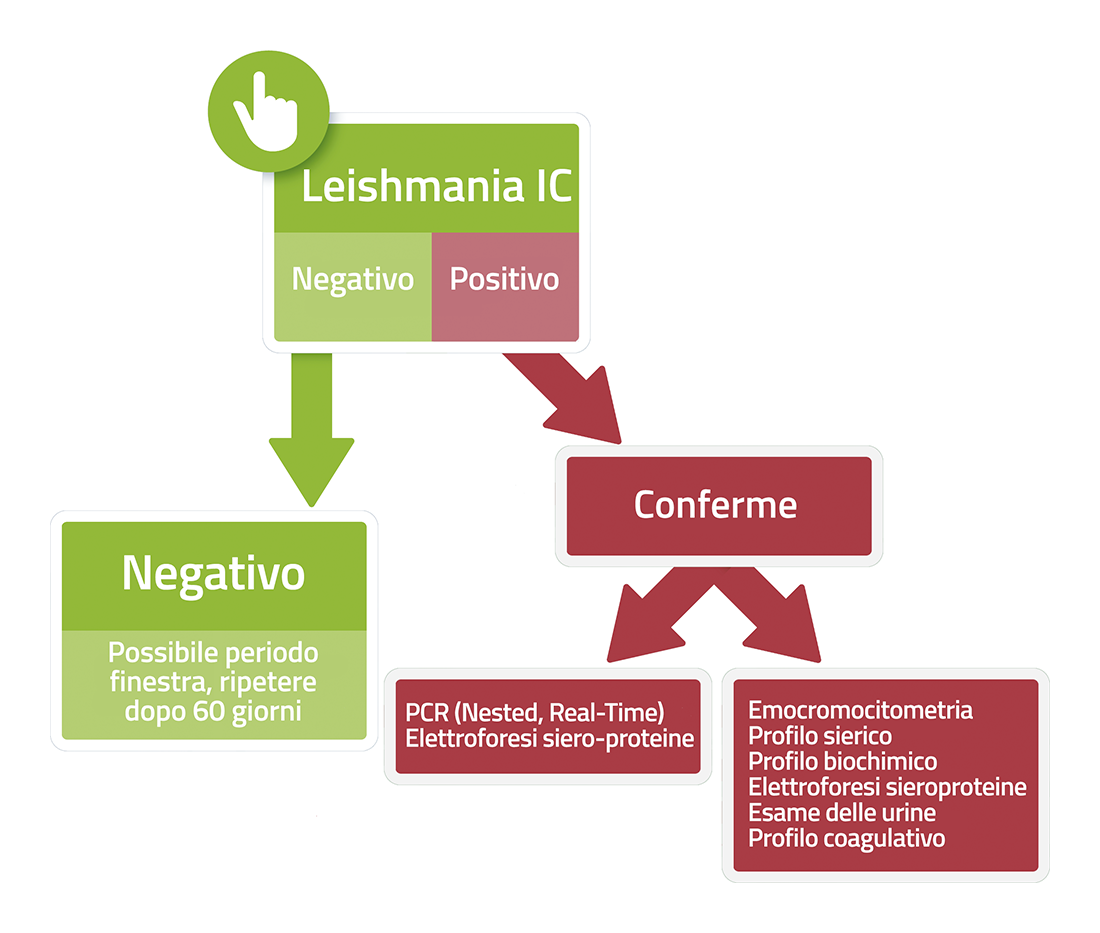Ehrlichia-Leishmania IC
Rapid test for the detection of Ehrlichia canis and Leishmania infantum antibodies
Ehrlichia / Leishmania IC is an immunochromatographic test for the detection of antibodies to Ehrlichia canis and Leishmania infantum in canine whole blood, serum or plasma.
Leishmania 93.7 %
Leishmania 100 %
CANINE EHRLICHIOSIS
Canine ehrlichiosis is a tick-borne disease caused by Ehrlichia canis, an intracellular parasite belonging to the Rickettsial genus, which infects red blood cells to the point of causing alteration of their functioning and destruction of platelets.
Ticks become infected by taking blood from a dog presenting with the disease, both in the larvae and nymph stages, act as a reservoir of disease and can transmit the infection to sensitive dogs for at least 150 days after acquiring the infection.
Ehrlichiosis has a worldwide spread; in Europe it is mainly present in Italy, Spain and Portugal.
The evolution and outcome of the infection depend on a large variety of factors, including the bacterial load received. The presence of concomitant diseases, sustained by other parasites carried by ticks or other pathogens, can influence the manifestations and severity.
There are no age or sex predispositions for ehrlichiosis, however the German Shepherd seems to be more susceptible than other breeds.
LEISHMANIOSIS
Canine Leishmaniasis is not easy to diagnose and treat. It is a parasitic pathology, caused by the protozoan Leishmania infantum, which is transmitted to the dog through the bite of an insect, the phlebotomist or sand fly. It looks like a small mosquito, both for its tapered appearance and for the fact that it is a blood-sucking fly.
Leishmania is a rather particular parasite because, in order to develop and multiply, it needs to have both the body of a phlebotomist and that of a mammal such as the dog available: the females of the phlebotomist have to bite the dog and suck the blood in order to lay the eggs. If the dog is infected, the Leishmania parasites move into the insect's stomach where they develop and multiply, becoming infectious. Thus, when the sand flies bite a healthy dog, parasites are transmitted through the bite.
The sand flies strike especially in the hot season, from May to October just like mosquitoes, they appear mainly at sunset and are widespread in tropical and sub-tropical areas and throughout the Mediterranean basin, including islands. With the gradual but inexorable increase in the earth's temperature, sand flies are slowly spreading even in areas with a more temperate climate, such as Northern Italy where there were no outbreaks until a few years ago.
In the dog there is substantially a generalized disease also called viscero-cutaneous form. Infection does not always lead to disease, in fact many infected dogs remain asymptomatic throughout their life, without developing clinical manifestations. The clinical picture of Leishmaniasis in dogs presents a great variability of symptoms and lesions that depend on the degree of infestation, the immune status of the host and the evolutionary moment of the disease and the infected organs.
When the disease develops, the symptoms are not immediate: they can appear after a few weeks or even a few months after the pappatacio bite, and they can occur individually or all together, at the same time.
CANINE EHRLICHIOSIS
The course of the disease was divided into three phases: acute, subclinical and chronic, based on clinical symptoms and clinical-pathological abnormalities.
The acute phase has a duration of 2 – 4 weeks, during which it is possible to observe symptoms such as:
- fever,
- oculo-nasal discharge,
- anorexia
- depression, lethargy,
- petechiae,
- bruising,
- lymphoadenomegaly in 20% of cases,
- splenomegaly in 25% of cases.
.
Most dogs recover from the acute form with appropriate therapy.
Untreated dogs can undergo the subclinical phase.
In this form, body weight normalizes and pyrexia resolves. Dogs appear clinically healthy, however their platelet counts may remain below reference values. Dogs can stay in this stage for years.
The chronic form is characterized by a reduction in haematopoiesis, which can lead to pancytopenia. The prognosis in this phase is poor, death occurs from secondary infections and / or haemorrhage.
Other symptoms that can arise are:
- eye symptoms: change in the color and appearance of the eye, blindness,
- retinal diseases, anterior uveitis,
- neuromuscular symptoms: meningitis and / or haemorrhagic state,
- neuropathies, convulsions, atrophic muscles,
- polyarthritis,
- concomitant or secondary infections.
.
LEISHMANIOSIS
Symptoms of cutaneous leishmaniasis:
- dry exfoliative dermatitis and progressive alopecia around the eyes, on the legs and on the back. Dermatitis can degenerate and give rise to lesions and ulcers – even without itching – which usually affect the eyes, ears, nose and mucous membranes; in severe cases, blood may also leak from these.
- Ulcers can cause swelling of the lymph nodes (in 90% of cases),
- Accelerated growth and abnormal thickening of the nails (onychogryphosis) (in 20% of cases),
joint pain and lameness including back pain: the dog often stands motionless, keeping his head down to seek relief (in 37.5% of cases),
.
Symptoms of visceral leishmaniasis:
- renal failure, polydipsia, polyuria (in 40% of cases)
- vomiting and diarrhoea, which result in loss of appetite and rapid and evident weight loss (in 64% of cases)
- neurological damage or even uremic coma.
- nosebleed (epistaxis) due to ulcers in the oral mucosa, in which parasites are present (in 15% of cases).
- ocular lesions, due to a uveitis and iridocyclitis and conjunctivitis (respectively in 1.3% and 32.5% of cases).


